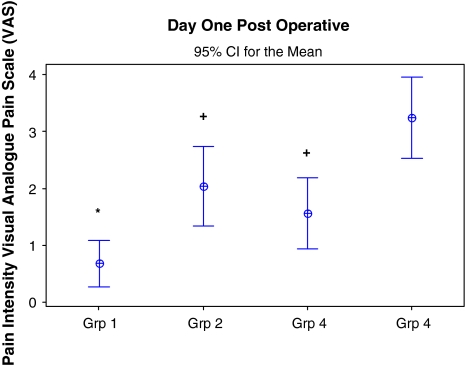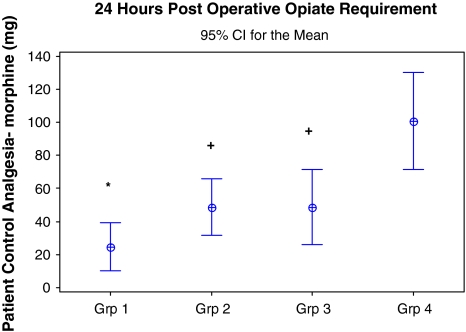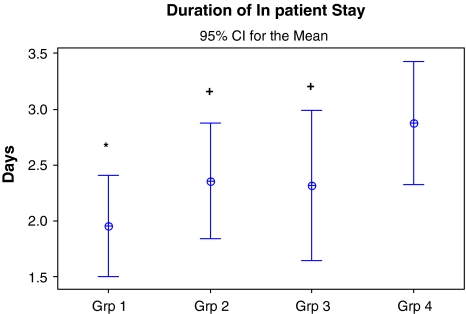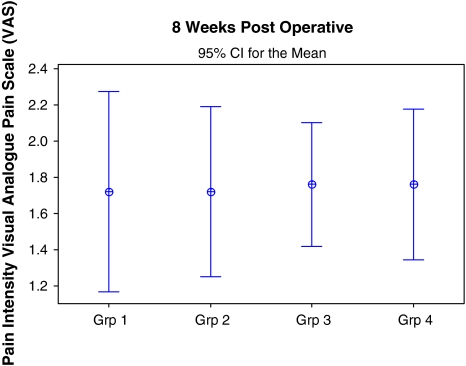Abstract
The study is a prospective blinded randomised controlled trial to compare the efficacy of triamcinolone acetonide, bupivacaine or in combination in managing pain after lumbar discectomy. Patients undergoing primary single-level lumbar discectomy were randomised. Triamcinolone acetonide, bupivacaine or in combination was instilled at the nerve root as decompression. Preoperative, day 1 and 6 weeks pain score, 24-h postoperative opiate requirements and duration of inpatient stay were recorded. Data was analysed using Mann–Whitney test for statistical significance. 100 patients were recruited. A significant difference was noted in day one postoperative mean pain score, mean 24-h opiate requirement and mean inpatient stay in the triamcinolone acetonide and bupivacaine group. At 8 weeks postoperatively, no significant differences were seen in the pain score in all groups. Significant postoperative pain reduction and opiate requirements in the first 24 h, and significantly shortened duration of inpatient stay were achieved in the triamcinolone acetonide and bupivacaine group compared with other groups.
Keywords: Pain management, Discectomy, Steroid, Local anaesthesia
Introduction
Pain management after lumbar discectomy is controversial. Modalities include oral medication, application of local anaesthetic or corticosteroid at the incision site [1], patient controlled analgesia and early physiotherapy [2]. Previous studies on the use of corticosteroid and local anaesthetic have been inconclusive [1, 3–5]. Furthermore, these studies were conducted using a broad spectrum of spinal surgical procedures. Jirarattanaphochai et al. [6] studied the effect of methylprednisolone and bupivacaine in multiple types of spinal surgical procedures and concluded that a mixture of methylprednisolone and bupivacaine was effective in managing pain post-lumbar discectomy but not decompression or fusion. Conversely, McNeill et al. [4] suggested than the use of methylprednisolone and morphine was insignificant in managing pain post-lumbar discectomy. Lowell et al. [7] noted a significant increase in infection rates in patients undergoing lumbar microdiscectomy who had steroid use as an adjunct in their pain management, which raised further concern regarding their usage.
Because of this conflicting evidence, this study was designed to investigate the efficacy of bupivacaine or corticosteroid alone, and in combination, which to our knowledge has not been previously investigated in this manner. We also had rigid patient selection criteria. Strict adherence to the selection criteria allowed us to focus only on patients undergoing primary single-level lumbar discectomy thus reducing the bias of different spinal procedures included in other studies.
Patients and methods
This study was ethically approved. Eligible patients were those undergoing primary single-level unilateral lumbar discectomy. All patients involved in the study had been diagnosed with a prolapsed intervertebral lumbar disc with nerve compression demonstrated on magnetic resonance imaging, with clinically correlated clinical findings and had failed conservative treatment prior to enrolment. Patients undergoing multiple level lumbar discectomies, instrumentation, fusion, discectomy for cauda equina syndrome or revision discectomy were not included. 100 patients were recruited into the study as calculated in the power study.
End points measured in the study were preoperative, day one and 8 weeks postoperative using pain intensity visual analogue pain scale (VAS), 24-h postoperative opiate analgesia requirement and duration of inpatient stay. 10 cm pain intensity visual analogue pain scale was used with 10 being the worst pain ever felt and 0 being no pain. Patients were asked to record their level of pain exclusive to the back. Pain intensity scores were recorded on day of admission, 24 h and 8 weeks postoperatively. 24-h postoperative opiate analgesia requirement was recorded by calculating the amount of opiate analgesia required by mean of patient controlled analgesia (PCA) administration. Patient controlled analgesia was administered and monitored by the anaesthetist as per our institution policy and they assessed patient analgesia requirement postoperatively. Patients were not limited to any specific pain medication. Duration of inpatient stay was calculated to the nearest day and recorded from day of admission to the day of discharge.
All patients involved in the study were randomised by a closed envelope system into four groups. Pharmacological agents used in the study were triamcinolone acetonide (Adcortyl) and bupivacaine hydrochloride (Marcaine). Group 1 was a mixture of 1 ml of 0.5% bupivacaine and 10 mg of Adcortyl in 1 ml. Group 2 was a mixture of 10 mg of Adcortyl in 1 ml and 1 ml of normal saline. Group 3 was a mixture of 1 ml of 0.5% bupivacaine and 1 ml of normal saline. Group 4 was 2 ml of normal saline, which acted as a control. All patients were blind to the randomisation and informed consent was obtained prior to enrolment into the study.
All procedures were performed by the senior author and pre-, intra- and post-operative management was standardised. Patients were positioned prone in a knee–chest position. The surgical level was identified using image intensifier and the exposure was obtained through standard microdiscectomy approach. The appropriate nerve root was identified and protected and the prolapsed disc was excised piecemeal with pituitary forceps. Based on the randomisation, a mixture of Adcortyl, bupivacaine or normal saline was applied topically over the nerve root prior to closure. Wound closure was performed in layers with no drain. Physiotherapy was started the next day and patients were discharged when safely mobilising. All patients were then followed up in the outpatient clinic at 8 weeks.
Statistical analysis
Power analysis was performed at the design stage of the study. The authors hypothesised that there was 0.82 probability that postoperative lumbar discectomy patients with bupivacaine with or without Adcortyl would report a lower pain score and require lower postoperative opiate analgesia compared to control with standard error of 0.5, power 80% and alpha value was 0.05 using Minitab software 1.5. A minimum of 88 patients in total (22 patients in each groups) were required to achieve sufficient power for the study. Results were compared using Mann–Whitney analysis and p value <0.05 was considered as statistically significant.
Results
One hundred patients were recruited into the study over 18 months duration from July 2005 to December 2006 and 25 patients were randomised into each group. There were no significant differences were in the mean age, gender and the mean preoperative pain score between all groups (Table 1). Mean day one pain score in group 1, 2, 3 and 4 (control) was 0.68 ± 0.98 (p < 0.05; statistically significant reduction when group 1 compared to all other groups), 2.04 ± 1.69 (p < 0.05; statistically significant reduction when compared to control group), 1.56 ± 1.50 (p < 0.05; statistically significant reduction when compared to control) and 3.24 ± 1.73 (Fig. 1). Mean 24-h postoperative opiate requirement was 24.7 ± 34.9 mg (p < 0.05; statistically significant reduction when group 1 compared to all other groups), 48.4 ± 41.4 mg (p < 0.05; statistically significant reduction when compared to control group), 48.7 ± 55.2 mg (p < 0.05; statistically significant reduction when compared to control group) and 100.7 ± 70.8 mg, respectively (Fig. 2). Mean inpatient stay was 1.9 ± 1.0 days (p < 0.05; statistically significant reduction when group 1 compared to all other groups), 2.3 ± 1.2 days (p < 0.05; statistically significant reduction when compared to control), 2.3 ± 1.6 days (p < 0.05; statistically significant reduction when compared to control) and 2.8 ± 1.3 days, respectively (Fig. 3).
Table 1.
Patients age, gender ratio and preoperative pain score
| Groups | Mean age | M/F ratio | Preoperative pain score (SD) |
|---|---|---|---|
| 1 | 39.3 | 14/11 | 8.3 (1.2) |
| 2 | 42.7 | 12/13 | 8.3 (1.0) |
| 3 | 41.8 | 16/9 | 8.4 (1.0) |
| 4 | 39.2 | 12/15 | 8.2 (1.1) |
Pain score was measured by the pain intensity visual analogue pain score (VAS) on the day of admission. Mean age, gender distribution and preoperative pain score was not statistically significant
SD standard deviation
Fig. 1.
Pain intensity visual analogue pain scale (VAS) day one postoperatively for all groups. The circle represents the mean pain score and the whisker represents the confidence interval. (group 1, Adcortyl and bupivacaine; group 2, Adcortyl only; group 3, bupivacaine only; group 4, control). (*p < 0.05 compared to all group, +p < 0.05 compared to control)
Fig. 2.
24-h postoperative opiate requirement in milligram (mg) for all groups. The circle represents the mean opiate requirement in 24 h postoperatively and the whisker represents the confidence interval. (group 1, Adcortyl and bupivacaine; group 2, Adcortyl only; group 3, bupivacaine only; group 4, control). (*p < 0.05 compared to all group, +p < 0.05 compared to control)
Fig. 3.
Duration of inpatient stay for all groups in days. The circle represents the mean duration of inpatient stay and the whisker represents the confidence interval. (group 1, Adcortyl and bupivacaine; group 2, Adcortyl only; group 3, bupivacaine only; group 4, control). (*p < 0.05 compared to all group, +p < 0.05 compared to control)
A significant difference was noted in day one postoperative mean pain intensity score, mean 24-h opiate requirement and mean inpatient stay in group 1 when compared to the other 3 groups (Figs. 1, 2, 3). Statistically significant reductions in day one mean pain intensity score and mean 24-h opiate requirement were noted comparing the bupivacaine only and steroid only groups to control group but not to each other (mean day one pain intensity score comparing bupivacaine only to Adcortyl only group; p = 0.36, mean 24-h postoperative opiate requirement comparing bupivacaine only to Adcortyl only group; p = 0.58).
At 8 weeks postoperatively, no significant differences were seen in the pain score in all groups (Fig. 4).
Fig. 4.
Pain intensity visual analogue pain scale (VAS) 8 weeks postoperatively for all groups. The circle represents the mean pain score and the whisker represents the confidence interval. (group 1, Adcortyl and bupivacaine; group 2, Adcortyl only; group 3, bupivacaine only; group 4, control). (p > 0.05 comparing all groups)
The mean duration of inpatient stay was significantly reduced in both bupivacaine groups with or without Adcortyl when compared to the control group, but comparing between the treated groups, these findings are not statistically significant.
We had two complications in our cohort of patients. One patient had an arteriovenous fistula, which was rectified with stenting, and one patient had a deep tissue infection, which treated with multiple debridements and intravenous antibiotics. Both of these patients were in the Adcortyl and bupivacaine group.
Discussion
In our study, all the treated groups resulted in a statistically significant lower pain intensity scores compared to the control group.
The group that received Adcortyl only did show significant lower pain scores in postoperative pain scale and 24-h opiate requirement postoperatively compared to the control group. Modi et al. [8] found positive effect of corticosteroid in relieving back pain postoperative lumbar discectomy and noted the result of pain relief was significant for up to 1 month and Debi et al. [5] found in their study that significant pain relief was achieved in the immediate postoperative period and lasted until day six postoperatively. Our results would support the findings of these reports.
The groups that received bupivacaine with or without Adcortyl required a reduced amount of opiate analgesia 24 h postoperatively and had a significant reduction in pain score in comparison to the control group. These findings are consistent with previous reports that support the use of bupivacaine as adjunct for pain relief post-lumbar discectomy [1, 9–11].
Reduction in pain intensity and opiate requirement was noted when comparing Adcortyl only and bupivacaine only group to control but the results were not significant when compared to each other. We have not found any study that compared the use corticosteroid to local anaesthesia exclusively; thus, further study is needed to clarify these findings.
When we compared the results from bupivacaine with Adcortyl to bupivacaine only and Adcortyl only group, we found the pain relief achieved using bupivacaine and Adcortyl was significantly better compared to these two groups. We hypothesise that the corticosteroids provide a cumulative effect with bupivacaine thus resulting in a better analgesic effect.
The pathophysiology of pain in prolapsed intervertebral disc disease is multifactorial. Mechanical compression of the nerve root is not the only pain generator as previously thought [12]. Studies have demonstrated that inflammatory mediators also contribute significantly to the process. McCarron [13] demonstrated in his controlled animal model experiment that nucleus pulposus material exposed to dural sheath produces an inflammatory response which was confirmed on histological examination. Saal et al. [14] have demonstrated high levels of phospholipase A2 enzyme activity in the disc material from patients with nucleus pulposus herniations undergoing lumbar discectomy. This enzyme acts as a regulator of arachidonic acid in the inflammatory response cascade. Pain relief achieved from an antiinflammatory effect of corticosteroid can be explained due to inhibition of this enzyme.
Local anaesthetic agents act on the intracellular portion of the sodium channel and block sodium influx into nerve cells, which prevents depolarisation, thus reducing the action potentials generated by pain nerve fibres. The use of local anaesthetic agents as adjuncts for reducing incisional pain is well established. Reports of their efficacy in spinal surgery have been well supported in the literature where Milligan et al. [9] and Cherian et al. [10] have shown significant reduction in postoperative pain and opiate requirement.
We did encounter one case of deep infection in our cohort of patients who was in the Adcortyl and bupivacaine group. Reviewing previous large studies in infection rates after spinal surgery, these indicate infection rates between 1.9% and 4.4% [15–19]; the infection rate in our series of 100 patients (1%) is well below this range but we do acknowledge the number in our study was small in comparison. We noted that patients presented with surgical site infection at a median of 11–15 days postoperatively [15, 16, 18]. Therefore, our 8 weeks postoperative follow-up was adequate in identifying postoperative surgical site infection. These studies performed for identifying risk factors for surgical site infection in spinal surgery did not recognise the use of steroid as a significant risk factor [15–18]. Interestingly, one recent study found the use of intravenous steroid was associated with significant lower risk of surgical site infection [18]. Based on these evidences, no conclusion could be drawn regarding any association of steroid to postoperative wound infection, given the limited power of the study, but that further studies would be necessary to address that question.
There were limitations to our study. First, only the patients were blinded to the randomisation allowing the possibility of investigator bias. Second, ethical protocol prohibited us from limiting the use of analgesia as patient control analgesia was administered and monitored by the anaesthetist thus we were unable to standardise the application of analgesia postoperatively but the use of opiate analgesia were accurately measured using patient control analgesia. Third, no functional outcome was performed and clinical evaluation at 8 weeks postoperatively may lead to missing significant improvements in early function in certain sub-groups, and to a significant separation between groups that was lacking in the present analysis. Finally, in our institution, lumbar discectomy is performed as an inpatient procedure and patients can only be discharged when they are comfortable and deemed safe to mobilise after physiotherapy assessment. We acknowledge the mean duration of inpatient stay in our study does not reflect the practice of other institutions as this procedure maybe performed as a day case. The study was designed as a short-term study and partly performed in order to determine a pain management protocol that would allow for successful day case lumbar discectomy.
In conclusion, we have found that intraoperative application of Adcortyl and bupivacaine in combination applied to the nerve root prior to closure is safe and effective in the management of postoperative pain in primary single-level unilateral lumbar discectomy.
Conflict of interest statement
No benefits in any form have been received or will be received from a commercial party related directly or indirectly to the subject of this article.
References
- 1.Mirzai H, Tekin I, Alincak H. Perioperative use of corticosteroid and bupivacaine combination in disc surgery. A randomised controlled trial. Spine. 2002;27:343–346. doi: 10.1097/00007632-200202150-00003. [DOI] [PubMed] [Google Scholar]
- 2.Kjellby-Wendt G, Styf J. Early active training after lumbar discectomy. A prospective, randomized, and controlled study. Spine. 1998;23(21):2345–2351. doi: 10.1097/00007632-199811010-00019. [DOI] [PubMed] [Google Scholar]
- 3.Lavyne MH, Bilsky MH. Epidural steroids, postoperative morbidity and recovery in patients undergoing microsurgical lumbar discectomy. J Neurosurg. 1992;77:90–95. doi: 10.3171/jns.1992.77.1.0090. [DOI] [PubMed] [Google Scholar]
- 4.McNeill TW, Anderson GB, Schell B, Sinkora G, Nelson J, Lavender SA. Epidural administration of methylprednisolone and morphine for pain after spinal operation. A randomised, prospective comparative study. J Bone Jt Surg Am. 1995;77:1814–1818. doi: 10.2106/00004623-199512000-00004. [DOI] [PubMed] [Google Scholar]
- 5.Debi R, Halperin N, Mirovsky Y. Local application of steroids following lumbar discectomy. J Spinal Disorder Tech. 2002;15:273–276. doi: 10.1097/00024720-200208000-00002. [DOI] [PubMed] [Google Scholar]
- 6.Jirarattanaphochai K, Jung S, Thienthong S, Krisanaprakornkit W, Sumananont C. Peridural methylprednisolone and wound infiltration with bupivacaine for postoperative pain control after posterior lumbar spinal surgery. A randomised double-blinded placebo controlled trial. Spine. 2007;32:609–616. doi: 10.1097/01.brs.0000257541.91728.a1. [DOI] [PubMed] [Google Scholar]
- 7.Lowell TD, Errico TJ, Eskenazi MS. Use of epidural steroids after discectomy may predispose to infection. Spine. 2000;25:516–519. doi: 10.1097/00007632-200002150-00020. [DOI] [PubMed] [Google Scholar]
- 8.Modi H, Chung KJ, Yoon HS, Yoo HS, Yoo JH. Local application of low-dose Depo-Medrol is effective in reducing immediate postoperative back pain. Int Orthop. 2009;33(3):737–743. doi: 10.1007/s00264-008-0547-6. [DOI] [PMC free article] [PubMed] [Google Scholar]
- 9.Milligan KR, Macafee AL, Fogarty DJ, Wallace RG, Ramsey P. Intraoperative bupivacaine diminishes pain after lumbar discectomy. A randomised double-blind study. J Bone Jt Surg Br. 1993;73:769–771. doi: 10.1302/0301-620X.75B5.8376436. [DOI] [PubMed] [Google Scholar]
- 10.Cherian MN, Mathews MP, Chandy MJ. Local wound infiltration with bupivacaine in lumbar laminectomy. Surg Neurol. 1997;47:120–123. doi: 10.1016/S0090-3019(96)00255-8. [DOI] [PubMed] [Google Scholar]
- 11.Chadduck JB, Sneyd JR, Poboreskin LH. The role of bupivacaine in early post operative pain control after lumbar decompression. J Neurosurg. 1999;90(Suppl 1):67–72. doi: 10.3171/spi.1999.90.1.0067. [DOI] [PubMed] [Google Scholar]
- 12.Sizer PS, Phelps V, Matthijs O. Pain generators of the lumbar spine. Pain Practice. 2001;1(3):255–273. doi: 10.1046/j.1533-2500.2001.01027.x. [DOI] [PubMed] [Google Scholar]
- 13.McCarron RF, Wimpee MW, Hudkins PG, Laros GS. The inflammatory effect of nucleus pulposus. A possible effect element in the pathogenesis of low back pain. Spine. 1987;12:760–764. doi: 10.1097/00007632-198710000-00009. [DOI] [PubMed] [Google Scholar]
- 14.Saal JS, Franson RC, Dobrow R, Saal JA, White AH, Goldthwaite N. High level of inflammatory phospholipase A2 activity in lumbar disc herniations. Spine. 1990;15:674–678. doi: 10.1097/00007632-199007000-00011. [DOI] [PubMed] [Google Scholar]
- 15.Wimmer C, Gluch H, Franzreb M, Ogon M. Predisposing factors for infection in spine surgery: a survey of 850 spinal procedures. J Spinal Disord. 1998;11:124–128. [PubMed] [Google Scholar]
- 16.Olsen MA, Mayfield J, Lauryssen C, Polish LB, Jones M, Vest J, Fraser VJ. Risk factors for surgical site infection in spinal surgery. J Neurosurg. 2003;98(2 Suppl):149–155. [PubMed] [Google Scholar]
- 17.Fang A, Hu SS, Endres N, Bradford DS. Risk factors for infection after spinal surgery. Spine. 2005;30:1460–1465. doi: 10.1097/01.brs.0000166532.58227.4f. [DOI] [PubMed] [Google Scholar]
- 18.Olsen MA, Nepple JJ, Riew KD, Lenke LG, Bridwell KH, Mayfield J, Fraser VJ. Risk factors for surgical site infection following orthopaedic spinal operations. J Bone Jt Surg Am. 2008;90:62–69. doi: 10.2106/JBJS.F.01515. [DOI] [PubMed] [Google Scholar]
- 19.Weinstein MA, McCabe JP, Cammisa FP., Jr Postoperative spinal wound infection: a review of 2,391 consecutive index procedures. J Spinal Disord. 2000;13:422–426. doi: 10.1097/00002517-200010000-00009. [DOI] [PubMed] [Google Scholar]






